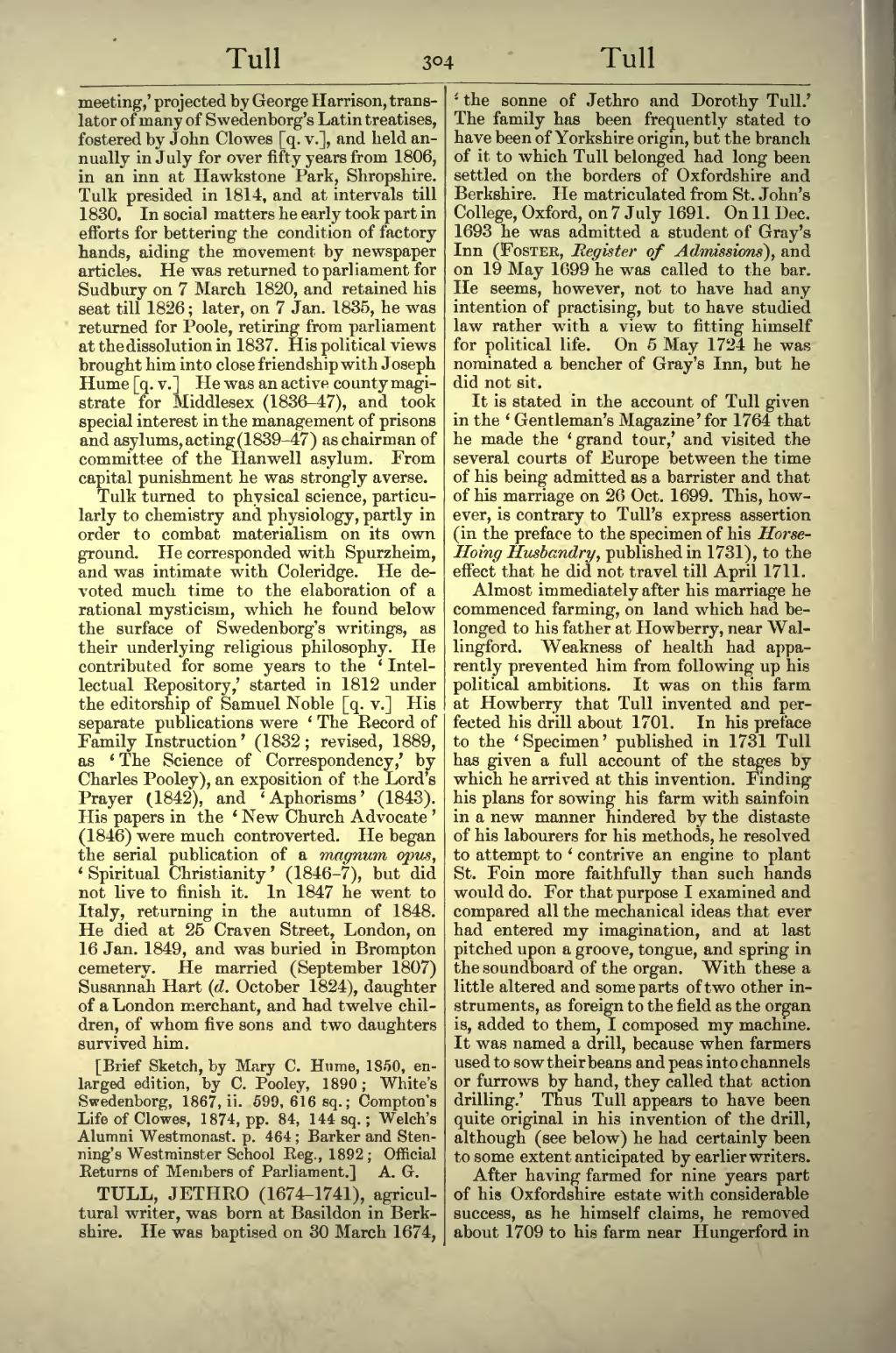meeting,’ projected by George Harrison, translator of many of Swedenborg's Latin treatises, fostered by John Clowes [q. v.] and held annually in July for over fifty years from 1806, in an inn at Hawkstone Park, Shropshire. Tulk presided in 1814, and at intervals till 1830. In social matters he early took part in efforts for bettering the condition of factory hands, aiding the movement by newspaper articles. He was returned to parliament for Sudbury on 7 March 1820, and retained his seat till 1826; later, on 7 Jan. 1835, he was returned for Poole, retiring from parliament at the dissolution in 1837. His political views brought him into close friendship with Joseph Hume [q. v.] He was an active county magistrate for Middlesex (1836–47), and took special interest in the management of prisons and asylums, acting (1839–47) as chairman of committee of the Hanwell asylum. From capital punishment he was strongly averse.
Tulk turned to physical science, particularly to chemistry and physiology, partly in order to combat materialism on its own ground. He corresponded with Spurzheim, and was intimate with Coleridge. He devoted much time to the elaboration of a rational mysticism, which he found below the surface of Swedenborg's writings, as their underlying religious philosophy. He contributed for some years to the ‘Intellectual Repository,’ started in 1812 under the editorship of Samuel Noble [q. v.] His separate publications were ‘The Record of Family Instruction’ (1832; revised, 1889, as ‘The Science of Correspondency,’ by Charles Pooley), an exposition of the Lord's Prayer (1842), and ‘Aphorisms’ (1843). His papers in the ‘New Church Advocate’ (1846) were much controverted. He began the serial publication of a magnum opus, ‘Spiritual Christianity’ (1846–7), but did not live to finish it. In 1847 he went to Italy, returning in the autumn of 1848. He died at 25 Craven Street, London, on 16 Jan. 1849, and was buried in Brompton cemetery. He married (September 1807) Susannah Hart (d. October 1824), daughter of a London merchant, and had twelve children, of whom five sons and two daughters survived him.
[Brief Sketch, by Mary C. Hume, 1850, enlarged edition, by C. Pooley, 1890; White's Swedenborg, 1867, ii. 599, 616 sq.; Compton's Life of Clowes, 1874, pp. 84, 144 sq.; Welch's Alumni Westmonast. p. 464; Barker and Stenning's Westminster School Reg., 1892; Official Returns of Members of Parliament.]
TULL, JETHRO (1674–1741), agricultural writer, was born at Basildon in Berkshire. He was baptised on 30 March 1674, ‘the sonne of Jethro and Dorothy Tull.’ The family has been frequently stated to have been of Yorkshire origin, but the branch of it to which Tull belonged had long been settled on the borders of Oxfordshire and Berkshire. He matriculated from St. John's College, Oxford, on 7 July 1691. On 11 Dec. 1693 he was admitted a student of Gray's Inn (Foster, Register of Admissions), and on 19 May 1699 he was called to the bar. He seems, however, not to have had any intention of practising, but to have studied law rather with a view to fitting himself for political life. On 5 May 1724 he was nominated a bencher of Gray's Inn, but he did not sit.
It is stated in the account of Tull given in the ‘Gentleman's Magazine’ for 1764 that he made the ‘grand tour,’ and visited the several courts of Europe between the time of his being admitted as a barrister and that of his marriage on 26 Oct. 1699. This, however, is contrary to Tull's express assertion (in the preface to the specimen of his Horse-Hoing Husbandry, published in 1731), to the effect that he did not travel till April 1711.
Almost immediately after his marriage he commenced farming, on land which had belonged to his father at Howberry, near Wallingford. Weakness of health had apparently prevented him from following up his political ambitions. It was on this farm at Howberry that Tull invented and perfected his drill about 1701. In his preface to the ‘Specimen’ published in 1731 Tull has given a full account of the stages by which he arrived at this invention. Finding his plans for sowing his farm with sainfoin in a new manner hindered by the distaste of his labourers for his methods, he resolved to attempt to ‘contrive an engine to plant St. Foin more faithfully than such hands would do. For that purpose I examined and compared all the mechanical ideas that ever had entered my imagination, and at last pitched upon a groove, tongue, and spring in the soundboard of the organ. With these a little altered and some parts of two other instruments, as foreign to the field as the organ is, added to them, I composed my machine. It was named a drill, because when farmers used to sow their beans and peas into channels or furrows by hand, they called that action drilling.’ Thus Tull appears to have been quite original in his invention of the drill, although (see below) he had certainly been to some extent anticipated by earlier writers.
After having farmed for nine years part of his Oxfordshire estate with considerable success, as he himself claims, he removed about 1709 to his farm near Hungerford in
